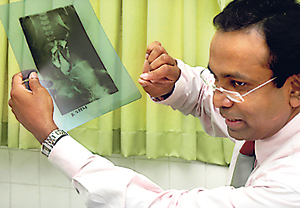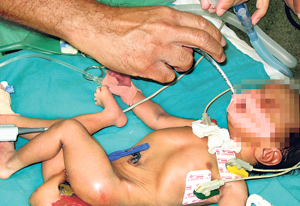The beautiful, bouncy baby boy is doing fine. Just a week old, he has travelled many miles, both physically and literally, during his short life-time.
The still-unnamed baby, has come from the place of his birth, Akkaraipattu to Colombo, undergone a major operation and is now at the Lady Ridgeway Hospital for Children (LRH).
He is unaware that he has made history in Sri Lanka, for he is believed to be the second baby to undergo surgery considered “risky and life-threatening”, as a conjoined twin. Sadly, the first, two girls on whom such surgery had been performed in September 2006 had died due to severe congenital heart problems.
Born through a normal delivery to his 18-year-old mother at the Akkaraipattu Hospital last Sunday, the baby who apparently had three legs and his mother were transferred by ambulance to LRH on Tuesday, where a team headed by Consultant Paediatric Surgeon Dr. Chandima Suriyarachchi took over.
Describing the five-hour operation performed on Wednesday, as a delicate and daunting challenge, Dr. Suriyarachchi explains that as soon as the baby arrived at LRH, a thorough examination and tests followed.
The team found conjoined twins of the ‘Heteropagus’ (the Greek word pagos means "that which is fixed") or asymmetrical type where there was a union of the mid-trunk from umbilicus downwards. This very type is also a form of ‘Parasitic twins’ with one twin being small, less formed and dependent on the other, he said.
The second twin was half-formed, explained Dr. Suriyarachchi, pointing out on X-rays the pelvis, small thorax, spine, intestine, one leg and a small part of the other leg. There seemed to be a shadow of a heart. Categorized as incomplete twinning and the most fascinating human malformation, the parasitic twin had no abdominal wall and as such the intestines were formed outside the body of the first twin, he added.
Conjoining occurs in one in 100,000 or 200,000 births, he says, adding that it tends to be more common in Southeast Asia and Africa than in the west. Among conjoined twins, as many as 70% would be girls, with boys forming a minority.
Fifty percent of conjoined babies are stillborn as their deformities are incompatible with life while of the balance, 25% do not survive a day, The Sunday Times understands. “Overall survival is about 25%,” says Dr. Suriyarachchi, explaining that in the case of the baby boy at the LRH, they did tests to make sure whose intestines belonged to whom before performing the delicate surgery. “Such surgery has to be very precise.”
The parents were also counselled, as there are many ethical, moral and legal issues in such surgical separations, he said. Before operations of this type, doctors need to talk to the parents about the possibility of both dying, which twin they should save in an emergency or simply whether the twins should be allowed to live as a joined entity.
Referring to the first surgical separation in Sri Lanka, he says, the two babies shared many organs including the heart sac. They had two hearts but one ventricle and although the doctors divided the liver etc, the decision as to which one they should save and which one they should sacrifice was more or less taken out of their hands because one twin was dependent on the other and had turned blue.
If conjoined twins are detected during the pregnancy by the Obstetrician, and it can be done through a simple scan, the delivery and hopefully the survival of the twins could be better managed, The Sunday Times learns. Then the expectant mother could be transferred to a hospital with facilities to deal with such an emergency, where the delivery could be carried out by the obstetric team along with a paediatric team headed by a Paediatric Surgeon and also a Paediatric Anaesthetist on hand.
 |
| Dr. Chandima Suriyarachchi |
This is an “in-utero transfer” (in the womb) where the babies would face the least danger and the delivery considered a “planned emergency”, says Dr. Suriyarachchi. Usually, the Obstetrician, in consultation with the paediatric team, would not await the full-term of pregnancy (38 weeks) but plan the delivery at around 36 weeks through a caesarian section if the babies are mature.
Such a planned caesarian section would provide a better chance of survival for the conjoined twins as it would pre-empt possible obstructed labour and foetal asphyxia, The Sunday Times understands.
Dr. Suriyarachchi assured mothers that even if the first birth has been of conjoined twins there is no danger of repetition of such pregnancies.
The baby boy has now been removed from the ventilator and is already being cuddled and breast-fed by his mother.
Hoping to name her little son within 40 days, the mother of the conjoined twin hopes to take him home to her husband in Akkaraipattu next week. The family will then be reunited, with her tiny son on the road to recovery from the surgery which has given him a chance to battle the odds thrown at him by nature.
All about conjoined twins
Conjoined twins are formed from a single fertilized egg which only undergoes incomplete separation at the embryological development stage. They are genetically identical, always of the same sex and share the same amniotic cavity and placenta.
Usually, twins develop either when a woman releases two eggs (fraternal twins) instead of the usual one or she produces only one egg but that divides after fertilization (identical or paternal twins).
Eng and Chang Bunker born in Thailand (then called Siam, thus the term Siamese twins) in 1811 were a set of famous conjoined twins.
They were joined at the lower chest by a narrow band of flesh, which connected their livers. They were put on show at circuses and later lived in the United States where they married and had several children. They died at the age of 63.
Some types of
conjoined twins
Conjoined twins are usually classified by the point at which they are joined.
Thoracopagus: This is the most common form of conjoined twins, connected on the upper front part of the torso. As they share a heart it is almost impossible to separate them.
Omphalopagus: Connected from the breast bone to the waist, this is another common form. These conjoined twins share a liver and gastrointestinal or genitourinary functions, but only rarely a heart.
Pygopagus: The twins are joined at the rump.
Craniopagus: The twins are joined at the cranium (the top of the head or skull). This is a rare form and difficult to separate though such surgical separations have been performed successfully.
Cephalopagus: Joined on the upper half of the body, with two faces on opposite sides of a conjoined head, sharing one heart. This is extremely rare.
Parasitic twins: Also called asymmetrical conjoined twins or heteropagus twins, they are extremely rare. There is an incomplete component (parasite) that is normally smaller and dependent on the host (autosite).
Foetus in fetu: An imperfect foetus is contained completely within the body of its sibling.
These mothers need a place to stay
Mothers of neonatal babies who are very ill or need specialized care (like the conjoined baby boy) from remote areas need a place of rest somewhere near the LRH, The Sunday Times understands.
This is necessary because they need to attend the LRH clinics with their babies during the early post-operative period.
If any organization looking after the interests of women and children can step in and provide accommodation to these mothers, it would be filling an acute need. |


